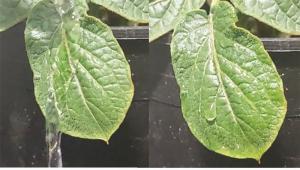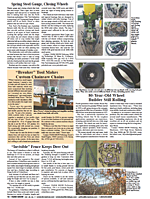Silica Spray Shows Promise Protecting Crops From Frost
 ✖  |
Will Short, a graduate student at the University of Saskatchewan, is researching a spray designed to reduce frost damage in early spring crops. His study focuses on canola, with some testing also conducted on potato plants. He’s hoping the results may be relevant to both vegetable producers and those involved in annual crop production.
After testing a previously researched kaolin clay spray from the U.S., Short began looking for a different solution.
“In my project, I’ve found that a spray based on hydrophobic silica is more effective as it has greater durability than the kaolin film when applied on canola,” Short explains.
The spray is made of hydrophobically modified fumed silica, ethanol and water. Hydrophobic fumed silica is used in a variety of products, such as inks, cosmetics and food. Once the dispersion is coated on the leaf, the ethanol and water evaporate, leaving behind a superhydrophobic layer. This layer can allow plants to begin freezing at lower sub-zero temperatures by blocking ice propagation into the leaf.
Short has tested his innovation mainly on canola seedlings (cotyledon to 4-leaf stage) and on recently emerged potato plants. From his small-scale testing, he’s found that the spray needs to be applied about a day before a suspected frost event to allow enough time for the coating to fully dry.
In lab tests, he found about a 6 C difference in nucleation time when freezing canola seedlings. In a small-scale outdoor trial last fall, he measured a 1.5 C (2.7 F) delay in freezing. This spring, there appeared to be some reduction in potato plant damage when moved outside before a frost event. All potato plants were damaged, yet the silica-coated plants had a lower number of totally top-killed plants.
Short plans to conduct more outdoor tests this fall, including a small field trial on sweet potatoes. A marketable, commercialized product is a possibility, although more research is needed regarding field types and crop applications. He believes the spray should first be validated by another lab group, and/or in another region or country.
Contact: FARM SHOW Followup, Will Short, University of Saskatchewan (will.short@usask.ca).

Click here to download page story appeared in.
Click here to read entire issue
Silica Spray Shows Promise Protecting Crops From Frost
Will Short, a graduate student at the University of Saskatchewan, is researching a spray designed to reduce frost damage in early spring crops. His study focuses on canola, with some testing also conducted on potato plants. He’s hoping the results may be relevant to both vegetable producers and those involved in annual crop production.
After testing a previously researched kaolin clay spray from the U.S., Short began looking for a different solution.
“In my project, I’ve found that a spray based on hydrophobic silica is more effective as it has greater durability than the kaolin film when applied on canola,” Short explains.
The spray is made of hydrophobically modified fumed silica, ethanol and water. Hydrophobic fumed silica is used in a variety of products, such as inks, cosmetics and food. Once the dispersion is coated on the leaf, the ethanol and water evaporate, leaving behind a superhydrophobic layer. This layer can allow plants to begin freezing at lower sub-zero temperatures by blocking ice propagation into the leaf.
Short has tested his innovation mainly on canola seedlings (cotyledon to 4-leaf stage) and on recently emerged potato plants. From his small-scale testing, he’s found that the spray needs to be applied about a day before a suspected frost event to allow enough time for the coating to fully dry.
In lab tests, he found about a 6 C difference in nucleation time when freezing canola seedlings. In a small-scale outdoor trial last fall, he measured a 1.5 C (2.7 F) delay in freezing. This spring, there appeared to be some reduction in potato plant damage when moved outside before a frost event. All potato plants were damaged, yet the silica-coated plants had a lower number of totally top-killed plants.
Short plans to conduct more outdoor tests this fall, including a small field trial on sweet potatoes. A marketable, commercialized product is a possibility, although more research is needed regarding field types and crop applications. He believes the spray should first be validated by another lab group, and/or in another region or country.
Contact: FARM SHOW Followup, Will Short, University of Saskatchewan (will.short@usask.ca).
To read the rest of this story, download this issue below or click
here to register with your account number.







